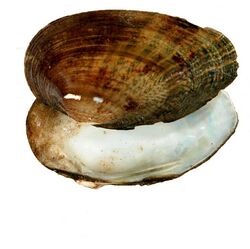Biology:Medionidus penicillatus
| Gulf moccasinshell | |
|---|---|

| |
| Scientific classification | |
| Domain: | Eukaryota |
| Kingdom: | Animalia |
| Phylum: | Mollusca |
| Class: | Bivalvia |
| Order: | Unionida |
| Family: | Unionidae |
| Genus: | Medionidus |
| Species: | M. penicillatus
|
| Binomial name | |
| Medionidus penicillatus (I. Lea, 1857)
| |
| Synonyms[4] | |
| |
Medionidus penicillatus, the gulf moccasinshell, is a rare species of freshwater mussel in the family Unionidae, the river mussels. This aquatic bivalve mollusk is native to Alabama, Florida, and Georgia in the United States, where it is in decline and has been extirpated from most of the rivers it once inhabited.[5] It is a federally listed endangered species of the United States.[2][3]
This mussel is up to 5.5 centimeters long. The shell is yellowish or greenish brown with green rays. The nacre of the shell is purplish or greenish with some iridescence.[3]
This mussel is native to the ACF River Basin, the watershed of the Apalachicola, Chattahoochee and Flint Rivers around the intersection of the states of Alabama, Georgia, and Florida. Its range has declined 80% from the known previous distribution. There are fewer than 20 occurrences and it is uncommon at most sites. It is now found in the Flint and Chattahoochee Rivers and four tributaries, and Econfina Creek. It is nearly extirpated from the state of Alabama.[5]
Like other mussels, this species releases larvae called glochidia that lodge in the gills of fish to develop into juvenile mussels. The host fish for this species include Etheostoma edwini (brown darter), Percina nigrofasciata (blackbanded darter), Gambusia holbrooki (eastern mosquitofish), and Poecilia reticulata (guppy),[5] as well as Etheostoma inscriptum (turquoise darter), Etheostoma swaini (Gulf darter), and Percina crypta (Halloween darter).[6]
References
- ↑ Bogan, A.E. (2000). "Medionidus penicillatus". IUCN Red List of Threatened Species 2000: e.T12928A3399032. doi:10.2305/IUCN.UK.2000.RLTS.T12928A3399032.en. https://www.iucnredlist.org/species/12928/3399032. Retrieved 15 November 2021.
- ↑ 2.0 2.1 "Gulf moccasinshell (Medionidus penicillatus)". U.S. Fish & Wildlife Service. https://ecos.fws.gov/ecp/species/7663.
- ↑ 3.0 3.1 3.2 USFWS (March 16, 1998). "Determination of endangered status for five freshwater mussels and threatened status for two freshwater mussels from the Eastern Gulf Slope Drainages of Alabama, Florida, and Georgia". Federal Register 63 (50): 12664–12687. 63 FR 12664
- ↑ "Medionidus penicillatus (Lea, 1857)". Integrated Taxonomic Information System. https://www.itis.gov/servlet/SingleRpt/SingleRpt?search_topic=TSN&search_value=80266.
- ↑ 5.0 5.1 5.2 NatureServe (5 May 2023). "Medionidus penicillatus". Arlington, Virginia: NatureServe. https://explorer.natureserve.org/Taxon/ELEMENT_GLOBAL.2.118702/Medionidus_penicillatus.
- ↑ Fritts, Andrea K.; Bringolf, Robert B. (2014-11-01). "Host Fishes for Four Federally Endangered Freshwater Mussels (Unionidae) in the Apalachicola-Chattahoochee-Flint Basin". Freshwater Mollusk Biology and Conservation 17 (2): 51. doi:10.31931/fmbc.v17i2.2014.51-59. ISSN 2472-2944.
Wikidata ☰ Q3015999 entry
 |



